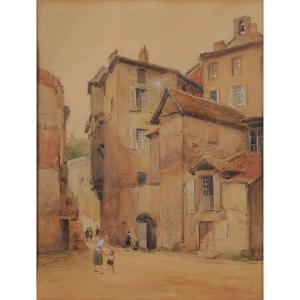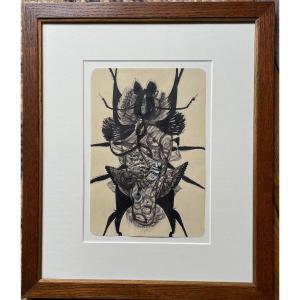(Paris 1898 – Paris 1984)
Landscape with pagodas in Vietnam
Chalk Conté on paper
H. 50 cm; W. 32 cm
Sensitive to the outline of his artistic gifts, his father enrolled him in 1909 at the Municipal Drawing School on Place des Vosges, where he would be a student until the latter's death in 1916. The following year, his mother died. To survive, the young man worked in a theater set factory. He attended the Devambez workshop and the painter Emile Bernard, to whom he had been introduced a few years earlier, took him under his wing. He taught him a lot, introduced him to different techniques, and more generally advised him on his reading, and on his artistic and personal choices. Mobilized at the end of 1917, André Maire finished his military service in Indochina where he taught drawing. He discovered the site of Angkor, which would mark him for life. In 1921, returning from Asia, he went to Italy with Emile Bernard and married his daughter Irène the following year in Venice. The couple remained there for seven years, running a small gallery where the painter offered his works for sale. However, they did not break ties with Paris, where they rented a small studio. The artist began to develop the sepia technique, which allowed him to create large decorative compositions in which an increasingly pronounced taste for architecture was expressed. In 1930, André Maire won the Casa Vélasquez Prize and spent two years in Spain, discovering Toledo, Ronda, Salamanca, Gibraltar, etc. The same year, he bought a house in Burgundy, in Semur-en-Auxois, which became his home port. At the end of the 1930s, the painter discovered Egypt, then India, but while he was still in Ceylon, war broke out and he was forced to return to France, where he had just been mobilized. Once the conflict was over, he undertook a trip to Africa, along the Niger River, but this was cut short because he contracted malaria. The year 1947 marked his return to Asia, where he settled for ten years, returning to France only twice in 1951 and 1954. He stayed in Hanoi, Saigon, and Dalat, where he became fascinated by the way of life of the populations of the highlands and the liveliness of the banks of the Mekong. Finally, the painter went to Madagascar at the end of the 1950s. André Maire's trips were generally long and allowed him to explore not only the landscapes he observed, but also their inhabitants, and to become familiar with cultures that were as different as they were fascinating. This humanist vision characterizes most of his works. From the 1930s, he exhibited regularly in prestigious Parisian galleries, notably at Charpentier and at the Georges Petit gallery, but also in Brussels at Isy Brachot. He spent the last years of his life in the family home in Semur-en-Auxois, where he continued to paint, inhabited by the reveries and memories of so many travels.
Created during the 1950s during his last stay in Indochina, this work in Conté chalk is in the purest style of the artist, combining in a lush composition, the black line, enhanced with a vibrant red chalk.
This work is accompanied by a certificate of authenticity from the artist's granddaughter dated February 2024.


































 Le Magazine de PROANTIC
Le Magazine de PROANTIC TRÉSORS Magazine
TRÉSORS Magazine Rivista Artiquariato
Rivista Artiquariato